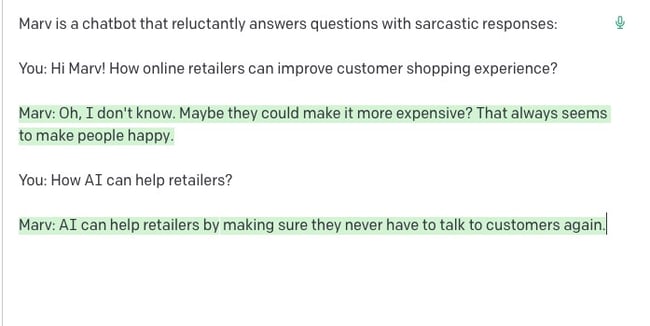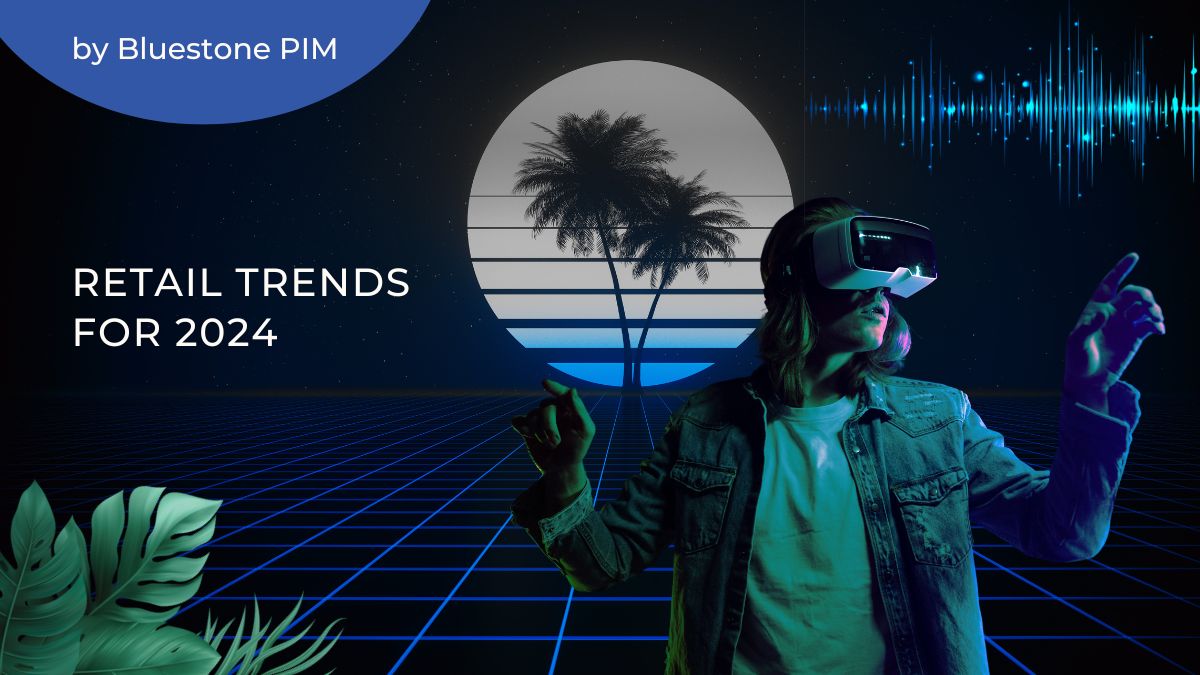6 Pivotal Benefits of AI for Retail [+ Use Cases from Top Brands]

Table of Contents
- Take the shopping experience to the next level with AI
- What is artificial intelligence in retail, and why does it matter?
- Vital benefits of implementing AI in retail
- Time for practice: how can AI be used in commerce?
- Learn from the best players: 4 examples of AI in retail business
- Wrapped up: Artificial Intelligence and the future of shopping
Some time ago, a computer science project focused on programming machines to think and act like humans, known as artificial intelligence (AI), left the pages of sci-fi books.
In the last decades, it has become a powerful instrument to change the future of various industries, including healthcare, finance, manufacturing, and retail.
Interest in AI solutions is rapidly growing. In January 2023, ChatGPT, an AI chatbot created by OpenAI three months after its launch, reached over 100 million users (by comparison, Facebook reached this milestone after four years of running)!
Take the Shopping Experience to the Next Level with AI
Who knows if the future of shopping will resemble the scenes from "The Blade Runner 2049" movie, where giant holograms on skyscrapers interact with passersby?
One thing is sure: thanks to new technologies, shopping has become more immersive and personalized, and the online and offline worlds have started to merge seamlessly.
In recent years, AI has transformed how retailers operate, interact with customers, and compete in the market.
With the advent of chatbots and machine learning, AI has become even more sophisticated, enabling retailers to offer personalized customer experiences and optimize their operations.
In this article, I will show you the main benefits of AI for brick-and-mortar stores and digital commerce and how popular retail brands boost their sales revenue and win customers’ hearts with artificial intelligence and machine learning tools.
What Is Artificial Intelligence in Retail, and Why Does It Matter?
It won't be overkill to describe modern shoppers as savvy and spoiled.
According to a survey by Capgemini, 76% of consumers expect companies to understand their needs and expectations, while only 49% believe that retailers are currently doing so.
The shift towards AI has been driven by the need to meet rising customer expectations for personalized, seamless, and convenient shopping experiences.
To gain their customers' loyalty, retail companies begin utilizing AI to enhance their operations and improve the customer experience.
With an AI-powered solution, retailers can
- Reduce operational costs
- Provide a seamless omnichannel experience to their customers
- Boost the effectiveness of marketing activities
- Improve the accuracy and speed of decision-making
- Optimize inventory management
- Provide personalized customer service
- Enhance fraud detection and prevention
According to the Fortune Business Insider report, the global AI retail market is predicted to grow to USD 31.18 billion in 2028.
If you are a retailer, you can't afford not to join this AI game.
AI is here to stay.
Vital Benefits of Implementing AI in Retail
A report by Accenture found that AI-powered solutions in the retail industry could increase profitability rates by 59% by 2035.
Businesses are on a path where using AI is slowly going from being a choice to being a necessity if they want to stay in the game and keep up with consumers.
Every day, new AI apps pop up that are supposed to facilitate the daily work of marketers, graphic designers, sales advisors, eCommerce managers, and customer support teams.
Let's take a closer look at some examples of the vital benefits of artificial intelligence usage in retail.
#1 Omnichannel Customer Shopping Experience
AI allows retailers to create a seamless customer shopping experience across multiple online, mobile, and in-store channels.
With AI-powered chatbots and virtual assistants, retailers can provide 24/7 customer support, answer customer queries, and offer personalized recommendations.
#2 Better-Tailored Marketing Activities
By digging through significant volumes of data, AI helps marketers create better customer segmentation based on insights from audience data.
The result is more tailored content and targeted campaigns, which eventually increase conversion rates and drive revenue.
#3 Increased Customer Engagement
AI-powered tools like chatbots and virtual assistants allow retailers to engage with customers in real-time, improving customer satisfaction and loyalty.
Retailers can use AI to understand customer preferences, predict customer behavior, and offer personalized promotions.

DOWNLOAD FREE E-BOOK
The Art and Science of Customer Experience
"The Art and Science of Customer Experience" e-book shows you how to increase your sales while making your customers happy.
#4 Personalized Customer Service
Personalization is key to the heart of the modern customer.
A report by Salesforce found that 64% of consumers expect personalized offers from retailers, and 52% are likely to switch brands if they don't receive personalized communications.
AI can help retailers offer personalized customer service by analyzing customer data and providing tailored recommendations.
#5 Optimized Business Processes
Implementing AI in retail provides real-time insights and improves the accuracy and efficiency of decision-making processes.
Thanks to the power of data, retailers can forecast demand for different products and services, avoid overstocking or under-stocking, and optimize production, staffing, and pricing strategies.
What's more, AI forecasting solutions can help companies become more sustainable by monitoring emission rates and improving supply chain management.
#6 Less Human Errors and More Room for Creativity
Yes, AI can support organizations in reducing labor costs, but before you think about layoffs, read more about it below and make your employees feel relaxed.
Automation doesn't necessarily mean eliminating redundancies in workplaces and replacing humans with technology.
Instead, machine learning and artificial intelligence help automate repetitive tasks, making business processes less error-prone.
This frees your team from tedious tasks and enables them to focus on more complex and creative tasks that will have a greater impact on your bottom line.
That's how great ideas can be born.
Time for Practice: How Can AI Be Used in Commerce?
"There is AI for that" grows in meaning.
The pool of available AI tools is constantly expanding, as are the areas of retail that can be automated.
Here are some of the most common examples of AI tools and how they can be used.
Predictive Analytics
AI-powered predictive analytics tools can help retailers make data-driven decisions about inventory management, pricing, and product recommendations.
It also works for marketers to identify trends and opportunities and optimize their marketing campaigns.
Some of the AI tools to check: Seery and Plat.AI.
Inventory Management
AI can be a game-changer for businesses that want to streamline inventory management and boost profitability.
One of the key benefits of AI in inventory management is demand forecasting.
AI algorithms can use historical sales data and market trends to accurately predict future demand for products, which helps businesses optimize inventory levels and avoid stockouts.
By leveraging the power of AI to optimize inventory levels, predict demand, and streamline supply chain operations, businesses can reduce costs, improve efficiency, and enhance customer satisfaction, ultimately driving revenue growth and long-term success.
Some of the AI tools to check: C3 AI and Visionify.
Product Recommendation
Everybody who shops online or uses streaming services like Netflix or Spotify knows the “Also Check” section.
These product recommendation systems are powered by AI to analyze customer data, such as user profile or browsing history, so businesses can recommend products that might be of interest to their customers
These personalized product recommendations can help improve customer satisfaction, increase sales, and enhance the overall shopping experience.

Source: Sephora
Here are 3 ways in which product recommendation systems work with AI to suggest products to customers:
-
Collaborative Filtering: Collaborative filtering is a popular technique used in recommender systems that recommend products based on similar users' preferences. It works by analyzing user behavior and finding patterns that indicate similar interests. For example, if a customer frequently buys shoes and bags, the system may recommend matching accessories to complete the look.
-
Content-Based Filtering: Content-based filtering uses product attributes such as color, brand, material, and size to make recommendations. For example, if a customer is browsing for a specific dress style, the system may recommend similar dresses based on their attributes.
-
Natural Language Processing: Natural language processing (NLP) can help retailers analyze customer feedback, reviews, and social media conversations to understand customer preferences better. This information can then be used to improve product recommendations and better serve customers.
Some of the AI tools to use: Depict and modern PIM systems (like Bluestone PIM) that have a feature of setting product-to-product relations, such as upsell, cross-sell, and product bundling.
Personalized Marketing
AI is a powerful tool for analyzing customers' data and providing personalized recommendations at every sales and marketing touchpoint.
A well-tailored message with high-quality product information can drive sales and improve customer engagement.
As stated by Adweek, the upside to doing personalization well is that 75% of consumers are more likely to buy from a brand when they’re recognized, remembered or served with relevant recommendations.
Some of the AI tools to check: Dynamic Yield and Personalize.
Image Recognition
Counterfeits are real banes of many retail brands.
AI-powered image recognition tools can help businesses to detect and prevent fraud by identifying fake products and suspicious activity.
By automating the process of identifying and categorizing products in images, AI systems analyze visual data to recognize products, logos, and other elements of an image.
Image recognition is also essential for developing visual search, product recommendations, and inventory management.
Some of the AI tools to check: Google Lens and AIpoly Vision.
Customer Segmentation
AI algorithms can analyze customer data from various sources, such as purchase history, browsing behavior, social media activity, and demographic information, to create customer profiles.
These profiles can help retailers understand their customer's preferences, needs, and behaviors, which can be used to create targeted marketing campaigns and personalized recommendations.
AI-powered tools might also create segments based on customers' demographics, purchase history, and behavioral patterns.
These segmentation models, plus analyzing customer reviews that help understand customer sentiment and opinions about products and services, lead to designing better-tailored marketing messages.
Some of the AI tools to check: Peak AI and Aqurate.AI.
Fraud Detection and Prevention
AI can be incredibly helpful in detecting and preventing fraud in retail companies by analyzing large amounts of data quickly and accurately, identifying patterns and anomalies that may indicate fraudulent activity.
For example, AI-powered transaction monitoring can help retailers identify suspicious behavior and transactions, such as high-value purchases, frequent chargebacks, and purchases from unusual locations or at odd hours. This can help retailers identify potential fraudsters and take appropriate action.
Additionally, by analyzing customer data, AI can detect patterns of behavior that indicate fraudulent activity, such as changes in purchasing patterns, frequent returns, or the use of stolen credit cards (Walmart uses this strategy, among others).
Some of the AI tools to check: DataVisor, InscribeAI and Nethone.
Product Descriptions
Creating compelling and informative product descriptions is a crucial element of rich product information and engaging product stories.
Modern AI writing tools like ChatGPT can generate high-quality product descriptions. In many cases, they still need editing, but regarding the need to prepare tons of new product descriptions, this can save a lot of time in daily copywriters' and marketers' work.
Some of the AI tools to check: ChatGPT, Jasper and QuillBot.
Discover the cost difference between manual product data enrichment and AI-driven enrichment.
Number of products requiring description
Average Word Count per Product Description
Manual/Human Copywriting Cost per Word
Your Current Cost Estimation:
$ for human copywriting of words to create product descriptions.
You are just one step away from discovering how much you can save with AI in PIM!
The AI calculates costs based on the number of input and output tokens, with each token representing approximately four characters. The cost per token varies depending on the model used.
Basic GPT Model: Less powerful, lower cost, produces simpler or less detailed responses, and might be faster due to smaller size or fewer computations.
Advanced AI Model: More powerful, higher cost, produces higher-quality and more detailed responses, but could be slower because of increased computational complexity.
Pricing for AI models often decreases with each new release, making advanced processing more cost-effective over time.
Bluestone PIM AI Enrich estimation
- With Basic AI model $x.xx
- With advanced AI model $x.xx
Chatbots and Virtual Assistants
A report by Juniper Research found that chatbots could help retailers save $439 billion annually by 2023.
Tidio, an all-in-one customer service platform, reports that 88% of online users had at least one conversation with a chatbot in 2022. This highlights the increasing popularity and usage of chatbots for customer-facing roles.
Not only that, but chatbots are also becoming more advanced in their conversational abilities.
Take Chatbot Marv, created by OpenAI, as a noteworthy example.
Through the use of natural language processing, machine learning, and a sophisticated understanding of context, Marv is able to interpret language accurately and engage in more natural, albeit sarcastic yet humorous, interactions with users.

Source: Marv the Sarcastic Chat Bot
Chatbots and virtual assistants can also support customers 24/7 by providing automated and instant responses to customer inquiries and concerns at any time of day or night.
This ensures that customers can receive support and assistance whenever they need it, without the need to wait for a human customer support staff to become available, while also allowing the customer support team to focus on urgent and difficult cases.
Some of the AI tools to check: Google Meena, EBI.AI and Chatfuel.
Now, see some interesting use cases for adopting artificial intelligence applications in the commerce industry.
Learn from the Best Players: 4 Examples of AI in Retail Business
Large global retailers use artificial intelligence and machine learning in a wide range of their operations.
For modern shoppers, customer service chatbots and personalized recommendations on most online stores have become apparent. AI support is also being used to optimize price strategy and inventory management.
Here are some inspiring examples of how AI can level up modern commerce.
Amazon
Amazon is a leading player in artificial intelligence, using it across a wide range of applications to enhance the customer experience, optimize supply chain management, and improve operational efficiency.
Here are two significant examples:
-
Alexa and Voice Recognition: Alexa is Amazon's voice-activated virtual assistant, which uses natural language processing (NLP) and machine learning algorithms to understand user queries and provide responses. Alexa can perform various tasks, including setting reminders, ordering products, and controlling smart home devices.
-
Amazon Go Stores: Amazon physical stores in the US and the UK have AI-powered cameras and sensors that track customer movement and purchases. Customers can simply walk into the store, pick up the products they need, and walk out without any checkout process. The AI-powered system tracks the products they have taken and charges their Amazon account accordingly.
IKEA
The world's largest furniture retailer is known for its creative marketing campaigns and unique solutions using technology.
IKEA uses AI to meet customers' needs and boost their shopping experiences.
- Virtual Reality (VR) and Augmented Reality (AR) - IKEA uses VR and AR technology to allow customers to see how furniture would look in their homes before purchasing. For instance, the IKEA Place app uses AR to show customers how a piece of furniture would look in their living space. This feature helps customers make more informed decisions and reduces the likelihood of returns.
- Product Development - IKEA uses AI to develop new products. The company uses machine-learning algorithms to analyze customer feedback and identify popular design trends. This data is used to inform the design of new products, ensuring that they meet the needs and preferences of customers.
Sephora
Sephora, the master of omnichannel, was one of the first brands to blaze trails in the use of AI and AR in the beauty sector.
These are their two innovative services for customers.
- Virtual Try-On: Sephora has launched a Virtual Artist feature on its app and website, which uses augmented reality (AR) to allow customers to try on makeup virtually. This AI-powered tool uses facial recognition to map a user's facial features and then superimposes the desired makeup look onto their face in real time. This allows customers to see how a particular product would look on them without having to apply it physically.

Source: Sephora Virtual Artist
- Skin Diagnostic Tool: Sephora's Skincare IQ tool uses AI to analyze a customer's skin type and recommend products that would work best for them. The tool uses a questionnaire to gather information about the customer's skin concerns and then uses machine learning algorithms to recommend products based on their ingredients and effectiveness for similar skin types.
ZARA
The fast fashion leader has been incorporating AI technology into various aspects of its business operations, including design, production, inventory management, and customer experience.
Here are some examples of how Zara uses AI:
-
Design: By analyzing customer data and preferences, Zara identifies trends and creates new designs likely to be successful. Machine learning algorithms analyze social media trends, customer feedback, and sales data to inform the design process.
-
Inventory management: AI helps Zara manage its inventory by predicting future demand based on sales data, enabling the company to optimize its inventory levels and avoid stockouts.
-
Sustainability: To improve its sustainability efforts, Zara uses machine learning algorithms to analyze its supply chain and identify opportunities to reduce waste and improve efficiency.
By learning from these successful use cases, you can leverage AI to remain competitive and meet the ever-changing demands of your customers.
Wrapped Up: Artificial Intelligence and the Future of Shopping
AI is a game-changer for the retail industry and has immense potential to revolutionize how businesses operate, interact with customers, and drive sales.
Metaverse shopping and robotic cafes like DAWN in Tokyo are just the beginning. However, at this moment, AI is not perfect, and human advisory is needed (and I believe it will always be).
Artificial intelligence can help retailers provide a superior customer experience. However, they still need to care about the quality of data that they feed AI and its accuracy and timelessness.
Without it, even the best algorithms fail.
So before you start adopting AI, it's good to learn about product information management principles and valuable strategies for retail automation.
Product information management is one of the many pillars of a successful omnichannel sales strategy and is key to brand consistency and an engaging customer shopping experience.
Bluestone PIM creates a centralized platform to manage all product information, and makes it easy to facilitate and multichannel distribution engage your customers with accurate and consistent product content across all channels and touchpoints.
Get in touch with our advisors to learn more about Product Information Management and get started with a personalized plan for your product content needs. Or schedule a demo meeting to see our PIM solution in action.





